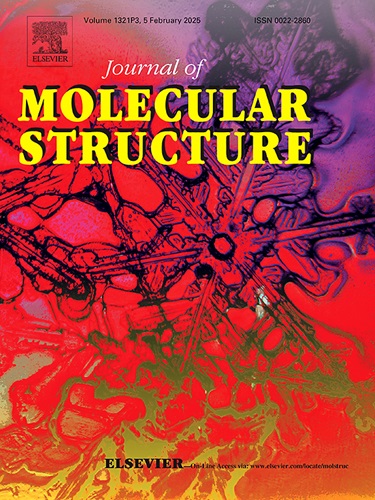MIL-101(Fe) nanoplatform for pH-triggered quercetin release: Unlocking potent pro-oxidant and anticancer synergy in breast cancer therapy
IF 4
2区 化学
Q2 CHEMISTRY, PHYSICAL
引用次数: 0
Abstract
This study aimed to design and synthesize a pH-controlled release nanocarrier, MIL-101(Fe), for load and targeted delivery of quercetin (Que), as a natural antioxidant, to MCF-7 cell breast cancer. Before and after Que loading, numerous analyses were directed to characterize the synthesized nanocomposite. High Que loading content (54.9 %) and its release behavior dependent on pH were observed through in vitro loading and release studies. The UV–vis analysis results indicated that MIL-101(Fe) exhibits a faster release rate at pH 5. The Que release profile was investigated for 9 days, and in this period (pH 5), 56.7 % of the total Que was released. To assess cell viability after treatment with Que, MIL-101(Fe), and Que@MIL-101(Fe), MTT assays were utilized to measure cytotoxicity on both MCF-7 breast cancer cells and MCF-10A normal cells for up to 48 h. The results demonstrated a stronger ability of Que@MIL-101(Fe) to inhibit MCF-7 cell growth while exhibiting significantly lower toxicity in MCF-10A cells, indicating selective cytotoxicity toward cancerous cells. The investigation of enzymatic and non-enzymatic antioxidants displayed an effective reduction in treated cells with Que@MIL-101(Fe). Molecular docking simulations were conducted against human liver CAT and SOD in order to verify the inhibitory effect of the Que. All obtained results have shown that this system can be a practical nanoplatform for successfully delivering Que to cancer cells and augmenting its anticancer effects while maintaining biocompatibility with normal cells, enhancing its therapeutic potential.
ph触发槲皮素释放的MIL-101(Fe)纳米平台:解锁乳腺癌治疗中有效的促氧化和抗癌协同作用
本研究旨在设计和合成一种ph控制释放的纳米载体MIL-101(Fe),用于负载和靶向递送槲皮素(Que),作为一种天然抗氧化剂,用于MCF-7细胞乳腺癌。在Que加载之前和之后,进行了大量的分析来表征合成的纳米复合材料。体外加载与释放实验观察到高Que含量(54.9%)及其随pH的释放行为。紫外-可见分析结果表明,MIL-101(Fe)在pH为5时释放速度较快。在9 d的时间内(pH为5),Que的释放率为56.7%。为了评估Que、MIL-101(Fe)和Que@MIL-101(Fe)对MCF-7乳腺癌细胞和MCF-10A正常细胞治疗后的细胞活力,我们利用MTT法测量了MCF-7乳腺癌细胞和MCF-10A正常细胞长达48小时的细胞毒性。结果显示Que@MIL-101(Fe)对MCF-7细胞生长的抑制能力更强,而对MCF-10A细胞的毒性明显较低,表明对癌细胞有选择性的细胞毒性。酶促和非酶促抗氧化剂的研究显示,Que@MIL-101(Fe)有效地减少了处理细胞。为了验证Que的抑制作用,我们对人肝脏CAT和SOD进行了分子对接模拟。这些结果表明,该系统可以作为一个实用的纳米平台,成功地将Que输送到癌细胞中,增强其抗癌作用,同时保持与正常细胞的生物相容性,增强其治疗潜力。
本文章由计算机程序翻译,如有差异,请以英文原文为准。
求助全文
约1分钟内获得全文
求助全文
来源期刊

Journal of Molecular Structure
化学-物理化学
CiteScore
7.10
自引率
15.80%
发文量
2384
审稿时长
45 days
期刊介绍:
The Journal of Molecular Structure is dedicated to the publication of full-length articles and review papers, providing important new structural information on all types of chemical species including:
• Stable and unstable molecules in all types of environments (vapour, molecular beam, liquid, solution, liquid crystal, solid state, matrix-isolated, surface-absorbed etc.)
• Chemical intermediates
• Molecules in excited states
• Biological molecules
• Polymers.
The methods used may include any combination of spectroscopic and non-spectroscopic techniques, for example:
• Infrared spectroscopy (mid, far, near)
• Raman spectroscopy and non-linear Raman methods (CARS, etc.)
• Electronic absorption spectroscopy
• Optical rotatory dispersion and circular dichroism
• Fluorescence and phosphorescence techniques
• Electron spectroscopies (PES, XPS), EXAFS, etc.
• Microwave spectroscopy
• Electron diffraction
• NMR and ESR spectroscopies
• Mössbauer spectroscopy
• X-ray crystallography
• Charge Density Analyses
• Computational Studies (supplementing experimental methods)
We encourage publications combining theoretical and experimental approaches. The structural insights gained by the studies should be correlated with the properties, activity and/ or reactivity of the molecule under investigation and the relevance of this molecule and its implications should be discussed.
 求助内容:
求助内容: 应助结果提醒方式:
应助结果提醒方式:


